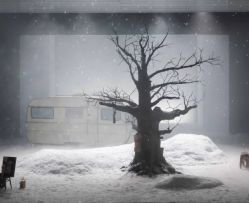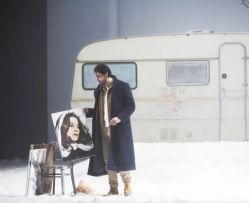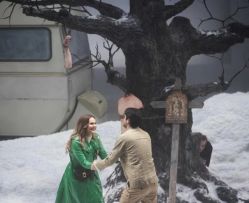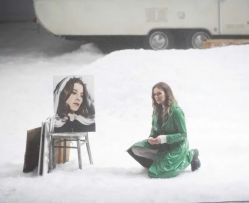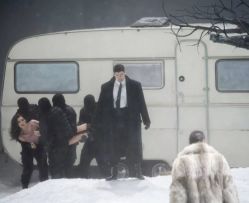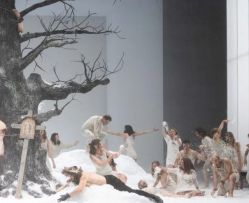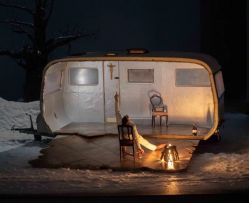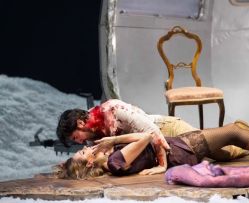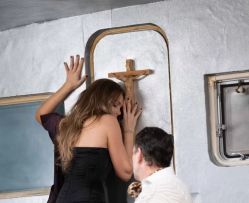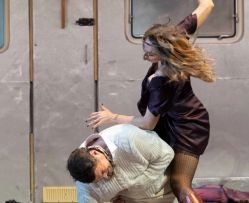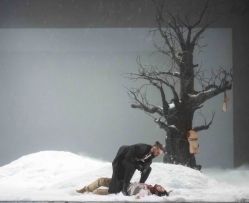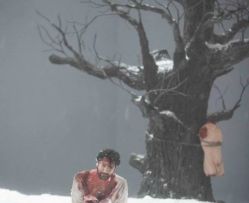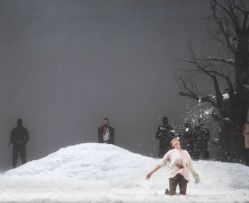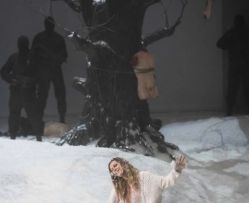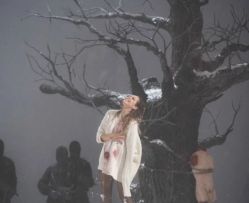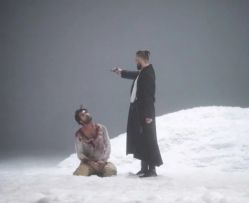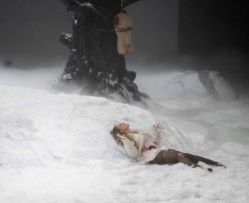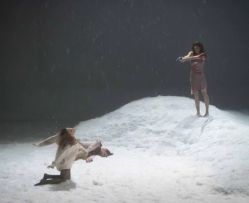Opera in three acts (1900)
Libretto by Giuseppe Giacosa and Luigi Illica based on the play La Tosca by Victorien Sardou
Premiere:
18 January 2022, 7 pm until 9.15 pm (no intemission)
Performances:
21 | 23 | 26 | 28 | 30 January 2022 | 7 pm until 9.15 pm (no intermission)
Introduction matinée:
16 January 2022, 11 am
In Italian with German surtitles
New production of Theater an der Wien
Information 15.01.2022:
Conductor Marc Albrecht replaces Ingo Metzmacher, who is ill, at short notice.
Cast
Synopsis
Rome, 1800: Cesare Angelotti has succeeded in escaping from the Castel Sant’Angelo, the notorious state prison, where he had been held as a political prisoner. He seeks refuge in the church of Sant’Andrea della Valle where he encounters his friend, the painter Mario Cavaradossi. Suddenly the latter’s lover, opera singer Floria Tosca, appears: she is suspicious because the church door was locked, and jealous because Cavaradossi’s portrait of the Madonna bears a striking resemblance to a real-life lady. However, Cavaradossi is able to calm her down. Tosca leaves. Alone again, Angelotti and Cavaradossi work on plans for his escape – but then a cannon fires, signalling that Angelotti’s escape has been noticed. The two of them leave the church. While the choir rehearses, Scarpia, the chief of police, bursts in and has his men search the church for the fugitive Angelotti. Tosca comes back into the church as well. Scarpia knows about the relationship between her and Cavaradossi and decides to make her jealous. He succeeds. Some time later he lures Tosca to his apartment in the Palazzo Farnese where Cavaradossi, who has been recaptured, is also brought to him. Cavaradossi is to be tortured until Tosca reveals Angelotti’s hiding-place. She does so, provoking Cavaradossi’s anger. Scarpia orders Cavaradossi’s execution unless Tosca gives herself to him, in which case he will let the painter go. Tosca agrees and Scarpia promises that the execution will only be staged. Tosca also manages to negotiate a safe-conduct pass from Scarpia that will allow her and Cavaradossi to leave Rome. As he is writing the document she stabs him. She then washes her hands, takes the letter from Scarpia’s lifeless fingers, tidies her hair and leaves. At the Castel Sant’Angelo she tells Cavaradossi that the execution will only be faked and gives him his instructions: after the first shot is fired he should fall down and lie still. But the firing squad is in fact genuine: Scarpia gave orders that Cavaradossi is really to be executed. In the meantime the police have discovered Scarpia’s body and are now after Tosca. When she realises that Cavaradossi is really dead she dashes up to the top of the Castel Sant’Angelo and plunges to her death.
Giacomo Puccini’s fifth opera, Tosca, brought him success but at the same time split public opinion. It was probably Puccini himself who first had the idea of adapting Victorien Sardou’s play La Tosca (1887, Paris) as an opera. In 1889 he attended a performance of La Tosca and afterwards asked his publisher Ricordi to secure the rights from Sardou for a setting. Because he was busy fulfilling other obligations, it was not until 1895 that Puccini asked Ricordi how things stood with regard to Tosca. The rights had been secured, Luigi Illica had been chosen as the librettist, Giuseppe Giacosa was also recruited and even Victorien Sardou is said to have been heavily involved in creating the libretto. Once the libretto was finished – the collaboration of the authors was anything but easy – Puccini began writing the music in the summer of 1898. According to an entry in his diary, he completed work on Tosca in September 1899. The opera was successfully premiered on 14 January 1900 at the Teatro Costanzi in Rome under Leopoldo Mugnone. The first really triumphant success followed two months later with the premiere at La Scala in Milan under Arturo Toscanini. Since then Tosca has been a fixture of the operatic repertoire. Verismo was no longer a novelty by this time, but it has seldom been displayed with such brutality in an opera: murder, torture and love, jealousy and passion – all can be found here to excess. It is for this reason that this political thriller in music caused considerable controversy: the main accusation levelled against verismo was that it was a kind of derivative sensational theatre, a box of cheap tricks, as we might say today. Julius Korngold derided Tosca as toe-curling melodrama, and Richard Specht called it “trashy theatre of the most hypocritical kind”. The unanimous assessment of contemporary critics was that it was musically too crude and lacking in poetry. Only after 1945 was the story of the deeply religious Tosca, the passionate Cavaradossi and the sadistic Scarpia subjected to psychological interpretation. The drama on the stage is accompanied by succinct character studies from the orchestra pit but, as usual in Puccini, also by lyrical twists and beautiful melodies that make this operatic shocker unique.
About the opera
Giacomo Puccini’s fifth opera, Tosca, brought him success but at the same time split public opinion. It was probably Puccini himself who first had the idea of adapting Victorien Sardou’s play La Tosca (1887, Paris) as an opera. In 1889 he attended a performance of La Tosca and afterwards asked his publisher Ricordi to secure the rights from Sardou for a setting. Because he was busy fulfilling other obligations, it was not until 1895 that Puccini asked Ricordi how things stood with regard to Tosca. The rights had been secured, Luigi Illica had been chosen as the librettist, Giuseppe Giacosa was also recruited and even Victorien Sardou is said to have been heavily involved in creating the libretto. Once the libretto was finished – the collaboration of the authors was anything but easy – Puccini began writing the music in the summer of 1898. According to an entry in his diary, he completed work on Tosca in September 1899. The opera was successfully premiered on 14 January 1900 at the Teatro Costanzi in Rome under Leopoldo Mugnone. The first really triumphant success followed two months later with the premiere at La Scala in Milan under Arturo Toscanini. Since then Tosca has been a fixture of the operatic repertoire. Verismo was no longer a novelty by this time, but it has seldom been displayed with such brutality in an opera: murder, torture and love, jealousy and passion – all can be found here to excess. It is for this reason that this political thriller in music caused considerable controversy: the main accusation levelled against verismo was that it was a kind of derivative sensational theatre, a box of cheap tricks, as we might say today. Julius Korngold derided Tosca as toe-curling melodrama, and Richard Specht called it “trashy theatre of the most hypocritical kind”. The unanimous assessment of contemporary critics was that it was musically too crude and lacking in poetry. Only after 1945 was the story of the deeply religious Tosca, the passionate Cavaradossi and the sadistic Scarpia subjected to psychological interpretation. The drama on the stage is accompanied by succinct character studies from the orchestra pit but, as usual in Puccini, also by lyrical twists and beautiful melodies that make this operatic shocker unique.
